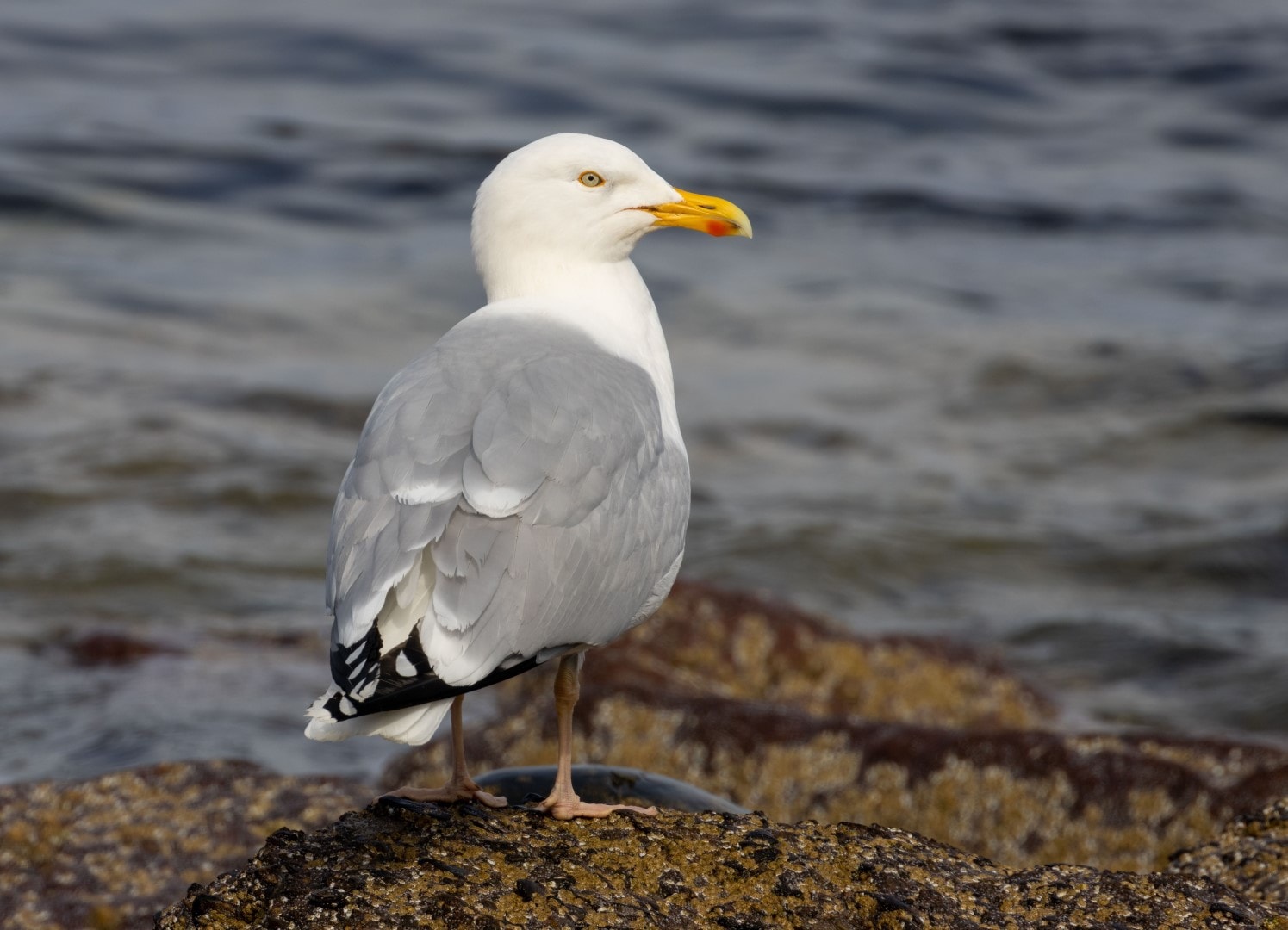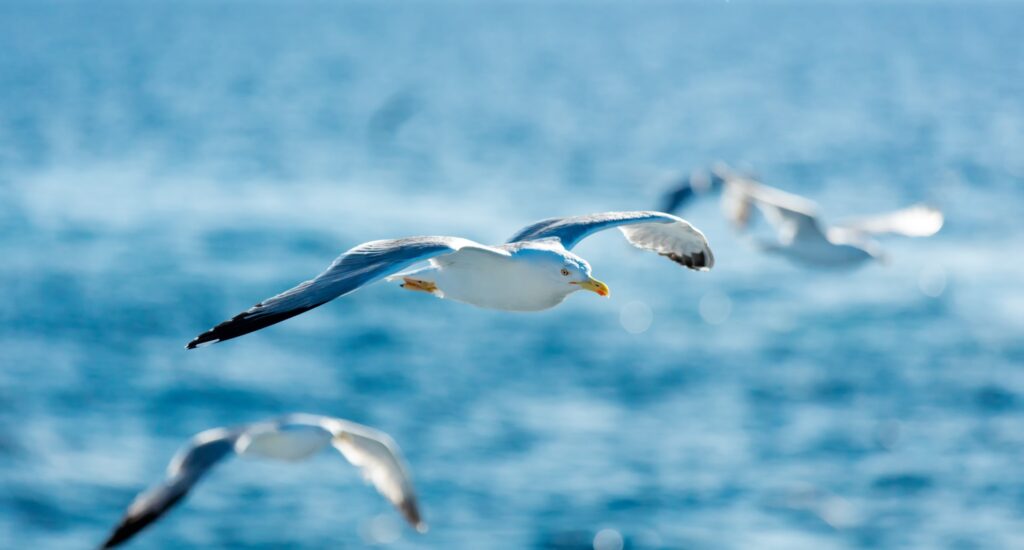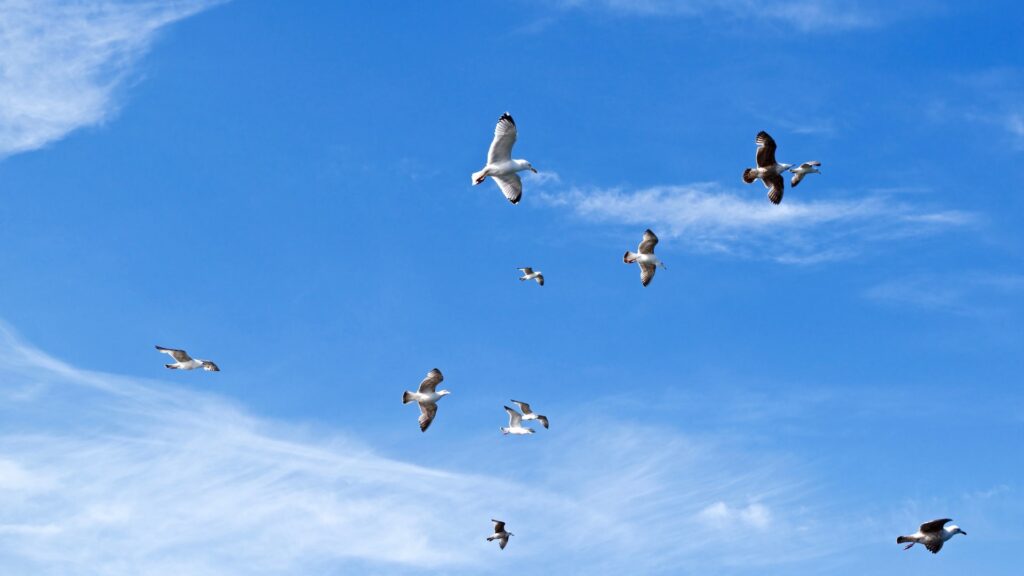Discover the Herring Gull
The Herring Gull (Larus argentatus) is one of the most familiar seabirds in the northern hemisphere, known for its adaptable nature and distinctive appearance. This page explores the life of the Herring Gull, highlighting its behaviors, habitats, and the challenges it faces in the wild.
Identification of the Herring Gull
Physical Description
Herring Gulls are large birds, with a body length of 55-66 cm and a wingspan of 130-158 cm. They are characterized by their heavy build, long wings, and stout bills. Adults have a white body and light grey back, with black wingtips spotted with white.
Differences Between the Sexes
Males and females are similar in appearance, though males are generally slightly larger and have a broader bill.
Plumage and Seasonal Changes
Juveniles start with a mottled brown appearance and gradually acquire the adult plumage over four years. Seasonal changes in plumage are not pronounced in adults.
Habitat and Distribution
Herring Gulls are found across a wide range of coastal and inland habitats, including shores, lakes, and garbage dumps. They breed in colonies along coastlines in North America, Europe, and Asia, and some populations migrate short distances for the winter.


Behavior and Lifestyle
Feeding
They have a varied diet, feeding on fish, invertebrates, insects, carrion, and human refuse. Their opportunistic feeding habits allow them to thrive in both natural and urban environments.
Social Behavior
Herring Gulls are social birds, especially during the breeding season when they nest in large colonies. They communicate with a range of calls and are known for their aggressive protection of nesting sites.
Migration
Some Herring Gull populations undertake migrations between their breeding and wintering sites, though many are resident year-round, depending on local climate conditions.
Reproduction
The breeding season starts in early spring. Herring Gulls nest on the ground or cliffs, laying 2-3 eggs. Both parents share incubation and chick-rearing duties.
Conservation and Status
While Herring Gulls are not currently considered endangered, their adaptability has led to conflicts with humans, and local populations can be affected by pollution and habitat destruction.


FAQ on the Herring Gull
Can Herring Gulls drink saltwater?
Yes, Herring Gulls possess special glands located near their eyes that filter out salt, allowing them to ingest seawater without harm. They excrete the excess salt through their nostrils.
How long do Herring Gulls live?
Herring Gulls have a relatively long lifespan, with individuals living up to 20 years or more in the wild. However, survival rates are lower for juveniles, with a significant number not reaching adulthood.
Are Herring Gulls monogamous?
Most Herring Gulls form monogamous pairs for the breeding season, and some pairs remain together for several years or even for life. Pair bonds are strengthened through shared nesting and feeding duties.
How can you tell the age of a Herring Gull?
The age of a Herring Gull can be estimated by its plumage, which changes distinctly over its first four years of life. Juveniles have mottled brown feathers, which gradually transition to the adult’s white and grey plumage.
Why do Herring Gulls steal food from other birds or people?
Herring Gulls are opportunistic feeders with a broad diet. Their behavior of stealing food, known as kleptoparasitism, is a strategy to conserve energy for other activities such as breeding and territory defense.
Do Herring Gulls have natural predators?
Adult Herring Gulls have few natural predators, but eggs and chicks are vulnerable to predation by mammals like foxes and raccoons, as well as other birds including crows, ravens, and birds of prey.
How do Herring Gulls impact their environment?
As scavengers, Herring Gulls play a crucial role in their ecosystems by helping to clean up dead animals and organic waste. However, in some areas, their large numbers can lead to conflicts with humans and potential negative impacts on other wildlife species.
What measures can be taken to reduce conflicts with Herring Gulls in urban areas?
Reducing food availability by securing trash, not feeding gulls, and managing waste more effectively can help minimize conflicts. It’s also important to respect nesting sites and avoid disturbing the birds during the breeding season.
How are Herring Gull populations currently faring worldwide?
While Herring Gulls are not considered endangered globally, local populations can face threats from habitat loss, pollution, and changes in food availability. Conservation efforts focus on monitoring populations and protecting habitats to ensure their long-term survival.
How to Help the Herring Gull
Supporting conservation efforts that protect coastal and marine environments can help maintain healthy Herring Gull populations. Reducing pollution and minimizing human interference at nesting sites are also crucial.
The Risks Associated With the Herring Gull
Seagulls invade urban environments and industrial parks and cause their share of inconveniences, as a colony can easily reach 5,000 individuals. Their presence on roofs can cause many problems: contamination by droppings carrying diseases, degradation of the roof membrane, or drain blockage. Protected by the laws concerning migratory birds, this species can only be controlled by certified professionals. The Bird Solution team has the expertise to effectively control harmful seagull colonies.

